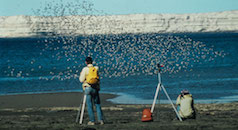Record Heat
Is it hot enough for you? Sounds like the set up for a bad joke, but the punch line here definitely isn’t funny. During the first half of 2016, we’ve experienced a dramatic spike in global temperature. Each of the first six months this year established a new benchmark for average global temperature in the modern temperature record (1880 – present). This is against the backdrop of record setting heat in 2014 and 2015. 2016 is now poised to be the third year in a row of record warmth.
The figure below shows how global temperature has increased during the period of 1880 to present. This increase is largely the result of the burning of fossil fuels and the corresponding increase in atmospheric CO2 levels. The saw-tooth pattern is produced by short-term cycles such as the El Niño/La Niña oscillation. Now that we are currently transitioning out of a strong El Niño, we may see another short-term downturn in global temperature, but the long-term trend will continue upward.

Source: http://www.nasa.gov/sites/default/files/thumbnails/image/2016temperature.png
Climate Sensitivity and Future Warming Rates
The rate of global warming in the future will be driven by greenhouse gas emission rates and several feedback mechanisms that affect the sensitivity of the climate to those emissions. One of these mechanisms is the linkage between Arctic sea ice coverage and ocean warming rates. Five of the first six months of 2016 set new records for smallest monthly sea ice coverage. As ice coverage diminishes, the oceans absorb more heat from the sun, which in turn reduces sea ice coverage and accelerates the warming of the oceans.
The interplay between a warming climate and cloud formation is among the most important unknowns in the sensitivity of climate to increasing greenhouse gas concentrations. Clouds can either enhance or retard warming based on changes in location, prevalence, and thickness. A recent study in the journal Nature finds two changes in cloud formation that are enhancing warming. The first is an expansion of the dry regions around 30 degrees latitude (subtropical dry zones) that is resulting in less reflection of solar radiation back into space. The second change is an increase in the height of the highest cloud tops at all latitudes. This shift enhances the heat trapping power of the clouds, increasing the greenhouse effect.
Call to Action
Taken in total, these recent findings show that the planet is warming rapidly and that the sensitivity of the climate to greenhouse gas emissions is increasing. Action is required on many fronts including both reducing greenhouse gas emissions and enhancing the ability of natural systems to stabilize the climate.
The Climate Services program at Manomet is focused on a natural systems-based approach to increasing carbon sequestration and storage. Our work in forests and coastal watersheds emphasizes the multiple benefits that accrue in maintaining and enhancing healthy forests and intact wetlands. In the words of Climate Smart Land Network member Richard Carbonetti, Senior VP Timberland at LandVest: “Climate change is and will have substantial impacts on our forests. Forests are critical to environmental health and sustainability worldwide. Therefore the forestry industry should assume a leadership position on climate change issues. The Climate Smart Land Network is helping to facilitate this transition by building a peer-to-peer network and providing actionable information on managing for climate change.”
For more climate information and to learn more about the Climate Smart Land Network, visit http://climatesmartnetwork.org/.





 Back to all
Back to all